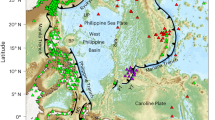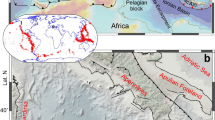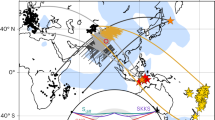Abstract
Most ultra-basic nodules that probably originated in the upper mantle have anisotropic petrofabric and elastic properties1,2. Within seismology, however, the Earth is generally assumed to be isotropic and this assumption is appropriate for most seismological studies. Thus, rocks can be considered isotropic on large scales although anisotropic on a scale of hand specimen3. This interpretation is questionable, however, in light of the increasing resolution of seismic observations. Many reliable reports on seismic anisotropies have been accumulating: for example, azimuthal anisotropy in Pn velocities in oceanic basins4, and in the continent5 and the back-arc basin6, and an S-wave splitting of the SH and SV waves revealing an anisotropic structure as deep as 190 km (ref. 7). These suggest that some unsuccessful detections of the Earth's anisotropies may be due to lack of appropriate observations. We describe here the recent discovery of shear wave anisotropy in a volcanic area in Japan, which was revealed by an improvement in the seismographic observation systems.
This is a preview of subscription content, access via your institution
Access options
Subscribe to this journal
Receive 51 print issues and online access
$199.00 per year
only $3.90 per issue
Buy this article
- Purchase on Springer Link
- Instant access to full article PDF
Prices may be subject to local taxes which are calculated during checkout
Similar content being viewed by others
References
Kumazawa, M., Helmstaedt, H. & Masaki, K. J. geophys. Res. 76, 1231–1247 (1971).
Christensen, N. I. Bull. geol. Soc. Am. 82, 1681–1694 (1971).
Ewing, W. M., Jadetsky, W. S. & Press, F. Elastic Waves in Layered Media (McGraw-Hill,New York, 1957).
Morris, G. B., Raitt, R. W. & Shor, G. G. J. geophys. Res. 74, 3095–3109 (1969).
Bamford, D. Geophys J. R. astr. Soc. 49, 29–48 (1977).
Okada, H. et al. J. Phys. Earth 26, Suppl. s491–s502 (1978).
Hirn, A. Geophys. J. R. astr. Soc. 49, 49–58 (1977).
Suyehiro, S., Ichikawa, M. & Tsumura, K. J. Phys. Earth 25, Suppl. s69–s78 (1977).
Kamitakara Crustal Movement Observatory and Research Section for Earthquake Prediction Bull. Disaster Prev. Inst., Kyoto Univ. 21, 119–135 (1978).
Aoki, H. J. Phys. Earth 22, 229–290 (1971).
Nur, A. & Simmons, G. J. geophys. Res. 74, 6669–6674 (1969).
Ichikawa, M. & Mochizuki, E. Pap. Meteor. Geophys. Jap. Meteor. Ag. 22, 229–290 (1971).
Birch, F. J. geophys. Res. 65, 1083–1102 (1960); 66, 2199–2224 (1961).
Christensen, N. L. & Ramananantoandro, J. geophys. Res. 76, 4003–4010 (1971).
Todd, T., Simmons, G. & Baldridge, W. S. Bull. seis. Soc. Am. 63, 2007–2020 (1973).
Matsuda, T., & Nakamura, K. & Sugimura, A. Tectonophysics 4, 349–366 (1967).
Isshiki, N., Matsui, K. & Ono, K. Selected Bibliography of Japanese Volcanoes (Japan Geological Survey, 1968).
Utsu, T. Kagaku (Science), Tokyo 44, 739–746 (1944).
Author information
Authors and Affiliations
Rights and permissions
About this article
Cite this article
Ando, M., Ishikawa, Y. & Wada, H. S-wave anisotropy in the upper mantle under a volcanic area in Japan. Nature 286, 43–46 (1980). https://doi.org/10.1038/286043a0
Received:
Accepted:
Issue Date:
DOI: https://doi.org/10.1038/286043a0
This article is cited by
-
Shear wave splitting and seismic velocity structure in the focal area of the earthquake swarm and their relation with earthquake swarm activity in the Noto Peninsula, central Japan
Earth, Planets and Space (2024)
-
Perfect circular polarization of elastic waves in solid media
Nature Communications (2024)
-
A review of a quarter century of International Workshops on Seismic Anisotropy in the crust (0IWSA–12IWSA)
Journal of Seismology (2009)
-
Evidence from shear-wave splitting for the restriction of seismic anisotropy to the upper crust
Nature (1988)
-
Evidence from core-reflected shear waves for anisotropy in the Earth's mantle
Nature (1984)
Comments
By submitting a comment you agree to abide by our Terms and Community Guidelines. If you find something abusive or that does not comply with our terms or guidelines please flag it as inappropriate.



